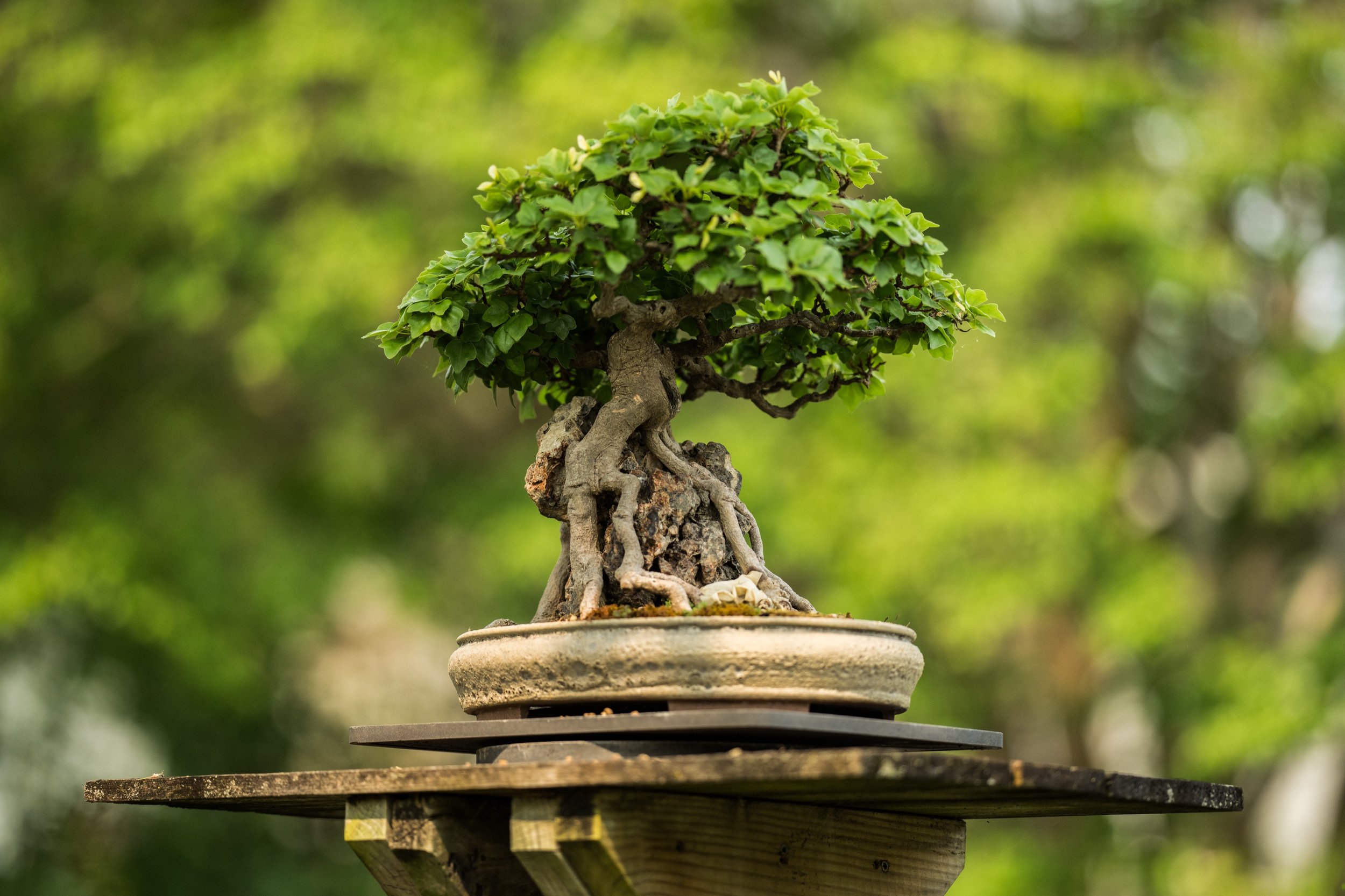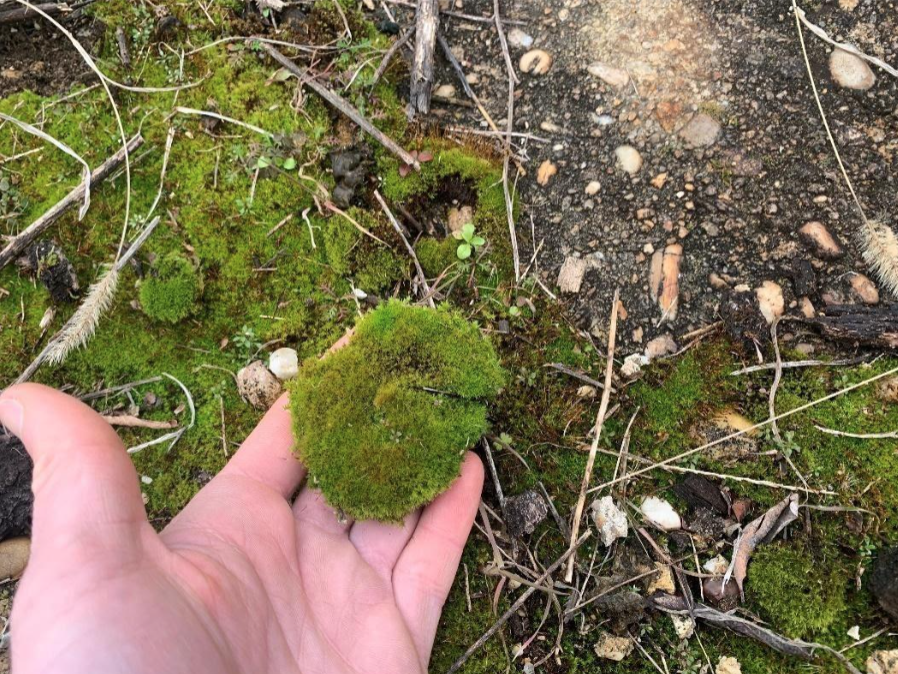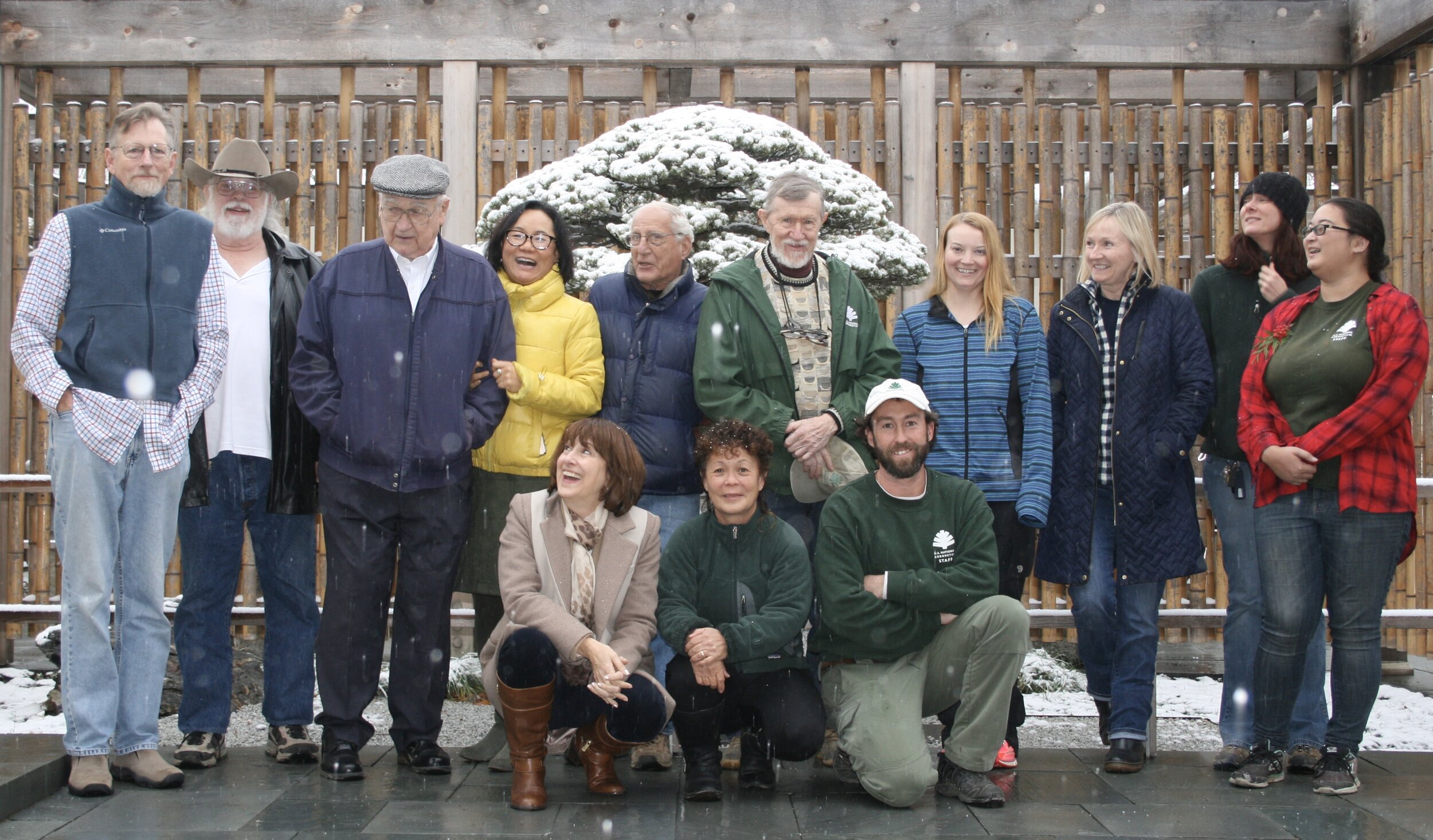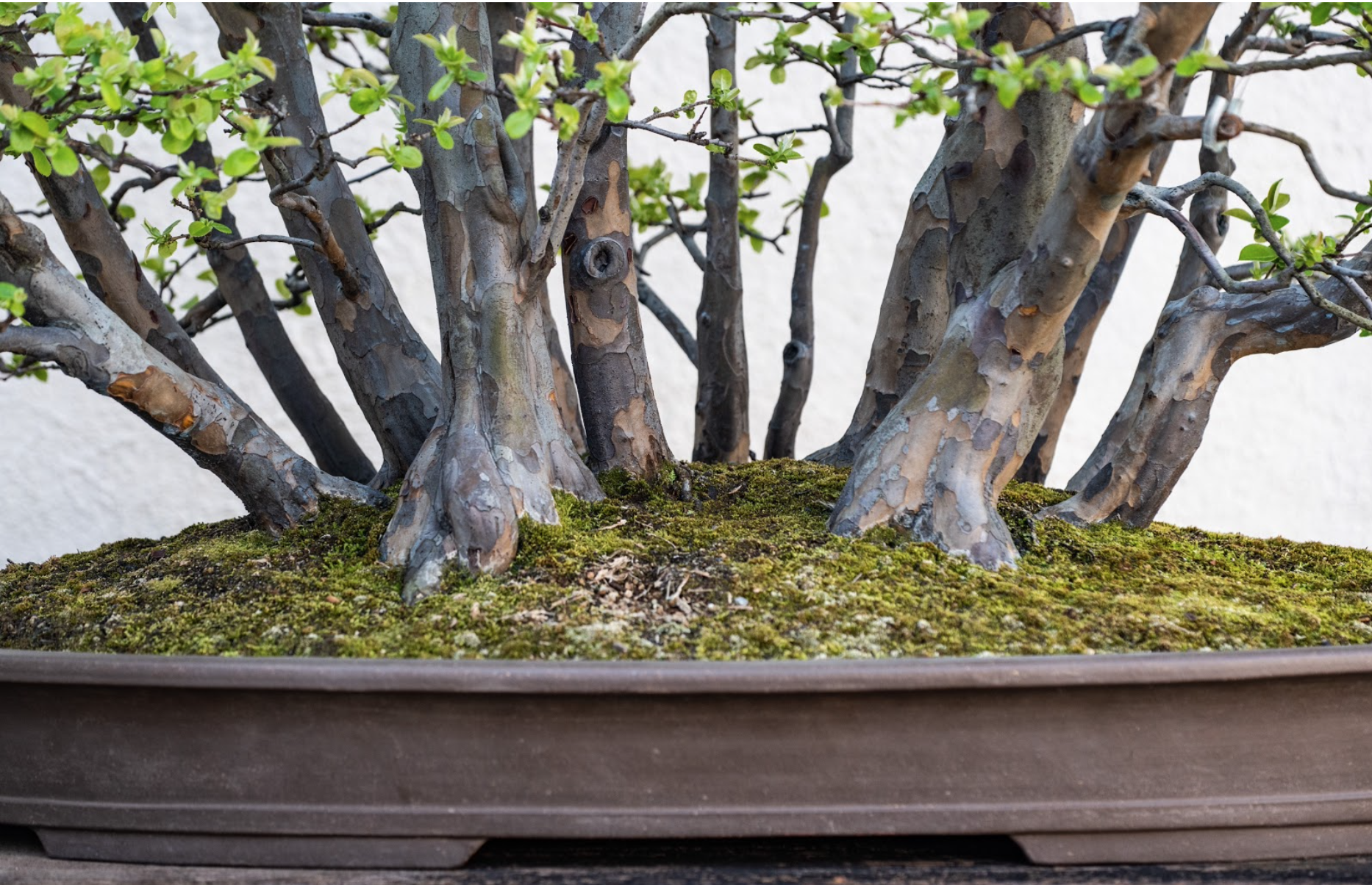Members of the National Bonsai Foundation’s (NBF) Board of Directors often have hands-on bonsai experience, but not many of them can say they helped build parts of the National Bonsai & Penjing Museum. Chin Fun Kwok can.
Assistant Curator’s Blog: Collecting Moss and Creating Top Dressing
As bonsai practitioners, we are always thinking about the past, present, and future aspects of our trees and the environments in which they live and grow. We constantly plan and prepare for the next step in the wonderful journey of bonsai and penjing. One preparation that can be completed any time of the year and is extremely important for the repotting process is collecting moss and creating top dressing.
Bonsai and penjing are commonly grown in small containers with inorganic substrate, or the layer of matter that helps trees grow and obtain nourishment. The substrate National Bonsai & Penjing Museum staff uses consists of the Japanese clay substrate called akadama, pumice, and lava rock, although substrates like tree bark and perlite could be used.
This well-drained substrate retains water to provide to the tree while allowing oxygen to flow through the soil, keeping the containerized tree healthy. To ensure the health of bonsai and penjing, a practitioner must constantly check and carefully manage watering to maintain the delicate balance of oxygen and water.
Moss is cultivated on the substrate surface by applying a layer of top dressing. This dressing is composed of local mosses typically collected from places like parking lots, driveways, or a nearby forest. The mosses may be mixed with high-quality sphagnum moss for larger tree collections. The live and sphagnum mosses are then ground to a smaller size, and soil and fine particles are removed.
All you need to collect moss is a container, a scraping tool and scissors, shown here.
The ideal moss is tight and low growing. Species that spread and climb will create issues when the moss grows up the trunks. This is especially problematic on rough bark trees, which will need to be sprayed carefully with vinegar to kill and remove the moss.
Once collected, place the moss in trays to dry, allowing for the soil and other fines to easily be sifted when grinding.
After the moss has dried, use bonsai substrate-sifting screens that are one-quarter, one-eighth, and one-sixteenth size. Take the moss and rub against the screens, starting with the one-quarter size. It may not be necessary to grind past the one-eighth size screen, depending on the size of the bonsai substrate, and the one-eighth screen can be used to remove the smaller particles.
The top left image shows the sphagnum moss before and after grinding. The top right image shows the locally collected moss before and after grinding. The bottom image shows both the ground sphagnum moss and the locally collected moss separately, as well as after mixing both together with about a one-to-one ratio.
Spread a thin layer of topdressing to cover the fresh substrate after repotting is complete.
Applying top dressing to the surface of bonsai and penjing at the end of the repotting process provides multiple benefits. The moss establishes the aesthetic of the composition, increasing its value. The moss layer also holds moisture in the top portion of the media, which would dry out much faster than the lower portion if left uncovered. The moss layer also helps prevent breakdown and erosion of the substrate in the container.
Once you collect moss, the empty trays can be filled with soil and a layer of top dressing. This allows you to propagate specific moss varieties and avoid having to collect moss each year from other sources.
As important as moss and top dressing is for bonsai and penjing, you also want to remember to follow and stay within specific guidelines. Although it may seem and sound harmless, it is not always legal to collect moss in every area you find, so be sure to always ask permission and obey trespassing signs if you are collecting!
Sincerely,
Andrew Bello
Assistant Curator
The National Bonsai and Penjing Museum
U.S. National Arboretum
NBF Celebrates National Volunteer Month
Museum volunteers enjoying the snow in 2017
In celebration of National Volunteer Month, the National Bonsai Foundation is paying tribute to the heartfelt, dedicated volunteers who assist the National Bonsai & Penjing Museum’s full-time staff in caring for the timeless and breathtaking trees in the national collection.
NBF is grateful for these volunteers who help make up the heart and soul of the Museum, infusing the spirit of bonsai into everything, from their technical duties to events and meetings that support the Museum.
But who are Museum volunteers, and what do they do?
Volunteers assist with the maintenance of the Museum's bonsai and penjing collections. Their duties range from cleaning to pruning and wiring trees. Typically, the Museum receives the help of 10 to 15 volunteers annually, and they generally work 4 to 6 hours per week. While some volunteers come and go, others have volunteered for decades and have even been involved with the Museum since its inception.
Museum Curator Michael James said past years have yielded an average of 2,000 annual volunteer hours. James said each volunteer offers the Museum a unique skill set and personal experiences in horticulture and the art of bonsai.
“The volunteers are generous enough to give something so valuable as their time,” he said. “The stories they tell are like pages from a horticultural history book.”
Volunteers Janet Lanman and Jim Rieden join Hughes, Museum specialist Kathleen Emerson-Dell and other bonsai club members in a discussion about bonsai. Photos courtesy of Jim Hughes.
Jim Hughes, NBF’s board chair and a former Museum curator, said constantly maintaining the show-ready condition of bonsai for public display is very labor intensive. The volunteers’ many hands help full-time Museum staff make light work of the hundreds of trees within the Museum’s collections.
“Volunteers help get the job done, week in and week out,” Hughes said. “As curator, I found them to be an invaluable resource that is skilled, dedicated and appreciative of their unique opportunity to work on these storied trees.”
He said some of his closest links to the local bonsai community during his time overseeing the collection from 2005 to 2008 were built around his weekly contact with Museum volunteers, who were bonsai club leaders and steadfast NBF supporters.
Volunteer Tom Inglesby helps Hughes repot the Ponderosa pine in the Museum’s grow out area.
Hughes added that his role as NBF’s board chair provides him with a heightened awareness of the significant contribution that these volunteers make to the Museum and the U.S. National Arboretum, in lieu of paid staff.
“Historically, in addition to their time and efforts at the museum, many of them are faithful NBF donors,” he said. “We are thankful to all of them for their hard work at the Museum and their philanthropic support of NBF's mission to promote the art of bonsai and penjing.”
A few of the volunteers Hughes worked with were original founders of the Museum and started their own local bonsai clubs that still thrive today.
“I am thankful I’ve had the opportunity to personally meet and work with these individuals that established the Museum as a national showcase of this beautiful art form,” he said. “I hope we can do them the honor of continuing to safeguard the legacy we have inherited.”
The Museum has been closed since mid-March 2020 and hopes to reopen soon, when it is safe for volunteers to return. Their enthusiasm for the national collection, bonsai and the related horticultural and artistic endeavors brings a vibrance to the Museum and NBF, and they have been greatly missed.
While we have had many volunteers over the years and are grateful for their service and giving, our current list of active volunteers is below.
Jennifer Amundsen
Josh Berer
Ross Campbell
Jack Chapman
Sundara Chintaluri
Young Choe
Scott Clinton
Olivia Cook
Chuck Croft
James Dail
Elizabeth Dame
Robert Drechsler
LeAnn Duling
Matthew Ferner
Pierre Gerber
Brian Gottlieb
Joseph Gutierrez, MD
Richard Hammerschlag
James Haworth
Nia Imani
Tom Inglesby
Richard Kang
David Lieu
Stephanie Mark
Garret Miller
Lee Palmer
Theodore Pickett, Jr.
Julie Pascu
Mike Rainwater
Steve Smith
Akiko Sprague
Lori Sullivan
Janice Vitale
Alexander Voorhies
Richard Winchester
Historical Tree Spotlight: Quince forest planting
The quince forest planting, photo by Stephen Voss 2021
One alluring aspect of bonsai is the ability to recreate an entire forest from a far away place all in a single pot. In this month’s Historical Tree Spotlight, we draw attention to a planting of Chinese quinces (Pseudocydonia sinensis) at the National Bonsai & Penjing Museum that does just that.
Former curator Warren Hill began this arrangement in 1975, growing the centermost and now-largest tree from nursery stock to produce quinces – a yellow, apple- or pear-like fruit (pronounced “kwins”) that is usually not eaten raw but is used in desserts or teas. He then collected seeds from the fruit of that parent tree to grow the surrounding trees.
Hill combined the parent and offspring trees to create the planting in 2002 and donated the arrangement to the Museum in July 2013.
Museum Curator Michael James said the trees are relatively similar in age, but Hill grew them to different sizes and shapes by paying special attention to his thickening technique.
“It’s really about how much foliage each tree is allowed to have,” James said. “Allowing a tree’s branches to really extend before cutting them off allows the trees to thicken faster, but trimming branches fairly often keeps a tree smaller.
Now that the forest planting is fairly developed, Museum staff keeps the foliage throughout the forest planting at a similar vigor to balance the leaf size with the trunk sizes and ensure the trees are proportional to each other.
“Maintaining this difference in height and thickness really drives home the true representation of how trees look in a natural forest environment,” James said.
He said the deciduous planting requires a lot of sun and a fair amount of water compared to other trees in the collection. The trees in Hill’s planting are some of the first to flower in the spring, and the quinces’ bark changes colors and textures throughout the year. But James said the planting peaks in the summer, when the bark exfoliates.
Warren Hill and the Chinese quince forest planting, photo credit to Walter Pall
“The smooth bark in the winter and early spring is a mixture of grays and tans and different browns, even greens,” he said. “But when that exfoliates and those colors flake off, it gives way to rosy oranges and pinks that look as if someone lit a match inside the heart wood.”
In the fall, if the flowers are pollinated, the trees grow their quinces, which are so large compared to their branches that Museum staff rarely leave more than one fruit on the composition each year.
First Curator’s Apprentice Sophia Osorio said the planting is protected in the greenhouse during the colder months, so the quinces don’t always have access to pollinators. Museum staff have to manually pollinate trees, taking a soft, bristled brush from flower to flower to transfer the pollen. Osorio said they will pick a few flowers to enlarge throughout the year and eventually grow fruit, but that takes some extra planning.
“We have to be careful that the branch we allow to flower is in the right place in the composition and will be able to support that fruit, yet not swell too much from developing,” she said.
Osorio added that the branch often has to be supported with wire because a fruit could easily snap a bonsai branch off by the time it matures in fall.
“The fruit draws tons of nutrients up from the roots, through the trunk, through the branch and to itself,” she said. “Due to that immense transfer of water and energy, the branch with the fruit is going to thicken a lot more than the others.”
Photo by Stephen Voss, 2021















